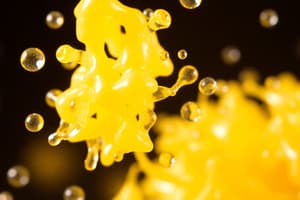Podcast
Questions and Answers
Which process involves the rhythmic contractions of muscles to move food through the esophagus?
Which process involves the rhythmic contractions of muscles to move food through the esophagus?
- Chyme Production
- Peristalsis (correct)
- Emulsification
- Segmentation
The primary function of the stomach is to absorb nutrients into the bloodstream.
The primary function of the stomach is to absorb nutrients into the bloodstream.
False (B)
What is the role of the epiglottis during swallowing, and why is it important?
What is the role of the epiglottis during swallowing, and why is it important?
The epiglottis covers the trachea, preventing food from entering the lungs.
The enzyme __________ in saliva begins the chemical digestion of starch, breaking it down into __________.
The enzyme __________ in saliva begins the chemical digestion of starch, breaking it down into __________.
Match each type of tooth with its primary function:
Match each type of tooth with its primary function:
Which component of gastric juice is responsible for activating pepsin from pepsinogen?
Which component of gastric juice is responsible for activating pepsin from pepsinogen?
The duodenum's primary role is water reabsorption.
The duodenum's primary role is water reabsorption.
What is the role of bile salts in the digestive process?
What is the role of bile salts in the digestive process?
The hormone __________ is released by the small intestine in response to acid chyme and stimulates the pancreas to secrete __________.
The hormone __________ is released by the small intestine in response to acid chyme and stimulates the pancreas to secrete __________.
What is the role of bacteria in the large intestine?
What is the role of bacteria in the large intestine?
Flashcards
What is digestion?
What is digestion?
Breaks down food into molecules absorbable by cells.
What is mechanical digestion?
What is mechanical digestion?
Breaking food into smaller pieces physically.
How many adult teeth?
How many adult teeth?
Adults have 32 teeth.
Four types of teeth?
Four types of teeth?
Signup and view all the flashcards
Enzyme in saliva?
Enzyme in saliva?
Signup and view all the flashcards
What is peristalsis?
What is peristalsis?
Signup and view all the flashcards
Functions of the stomach?
Functions of the stomach?
Signup and view all the flashcards
Pepsin's function?
Pepsin's function?
Signup and view all the flashcards
Function of the mouth?
Function of the mouth?
Signup and view all the flashcards
Small intestine's main role?
Small intestine's main role?
Signup and view all the flashcards
Study Notes
- Digestion is the breakdown of food into molecules that can enter our cells.
- Digestion breaks food into small molecules, absorption gets those molecules into the bloodstream.
- Chemical digestion breaks down food via chemical reactions, and mechanical digestion is the physical breakdown of food into smaller pieces.
- Adults have 32 teeth.
- Types of teeth include incisors for biting, canines for grabbing and holding, premolars for breaking food into small pieces, and molars for grinding food to a paste.
- There are 3 pairs of salivary glands.
- Sublingual glands are under the tongue, parotid glands are below the ears, and submandibular glands are below the lower jaw.
- Salivary amylase is the enzyme in saliva.
- The substrate of salivary amylase is starch and the product is maltose.
- In the mouth large food particles are mechanically broken down.
- Starch is chemically broken down in the mouth by salivary amylase.
- During swallowing the soft palate covers nasal passages and the trachea moves up to be covered by the epiglottis.
- This prevents food from entering the nose or lungs.
- Peristalsis in the esophagus involves rhythmic contractions of longitudinal and circular muscles to push food through the tube.
- The functions of the stomach include initial protein breakdown, killing bacteria via HCl, and food storage.
- Gastric juice is fluid secreted into the stomach.
- Gastric juice is produced by gastric glands in the lining of the stomach.
- Gastric juice contains pepsinogen and HCl.
- Pepsinogen and HCl combine to form pepsin.
- Pepsin breaks down proteins into peptides.
- The stomach is protected from self-digestion by a thick layer of mucus secreted by mucosal cells.
- The stomach's structure is stretchy for food storage and has muscle layers for churning/mixing food and gastric juices.
- Mouth: entry point for food and site of mechanical digestion/initial starch breakdown.
- Pharynx: tube at the back of the mouth allowing passage of food and air.
- Epiglottis: projection of tissue covering the trachea during swallowing.
- Cardiac sphincter: ring of muscle preventing stomach material from going back into the esophagus.
- Esophagus: long tube connecting the pharynx and stomach.
- Pepsinogen: molecule in gastric juice that becomes pepsin.
- The majority of digestion takes place in the small intestine.
- The small intestine increases surface area by being folded on the inside and having villi/microvilli.
- The three parts of the small intestine are the duodenum, jejunum, and ileum.
- The duodenum is the shortest part of the small intestine.
- The pyloric sphincter controls the flow of material into the duodenum.
- The material that enters the duodenum is called acid chyme.
- The main role of the duodenum in digestion is where digestive enzymes are secreted.
- The pancreas and liver produce secretions that end up in the duodenum.
- The liver produces bile, which is stored in the gall bladder.
- Bile salts emulsify fats.
- Pancreatic juice contains sodium bicarbonate.
- Sodium bicarbonate neutralizes the acid chyme.
- Pancreatic juice contains pancreatic amylase, trypsin, and lipase.
- Pancreatic amylase function: breaks starch into maltose.
- Trypsin function: breaks proteins into peptides.
- Lipase function: breaks triglycerides into fatty acids and glycerol.
- Interstitial glands produce intestinal juices.
- Interstitial glands are located in the lining of the small intestine.
- Intestinal juices contain peptidase and maltase.
- Peptidase function: breaks peptides into amino acids.
- Maltase function: breaks maltose into glucose.
- Villi increase surface area and contain blood vessels to carry nutrients into the bloodstream.
- Nutrient absorption takes place in the small intestine.
- The hepatic portal vein takes blood with collected nutrients from the intestines to the liver.
- The liver functions include interconversion of nutrients, recycling old red blood cells, detoxifying the blood, production of urea, keeping nutrient levels constant, and producing bile.
- Additional liver functions include manufacture of plasma proteins and cholesterol, storage of iron and vitamins, and producing red blood cells in embryos.
- The large intestine is larger in diameter and shorter than the small intestine.
- The large intestine's main functions is reabsorption of water and absorption of vitamins to produce feces.
- The small intestine is skinnier and longer and functions in digestion and absorption of nutrients
- Bacteria in the large intestine break down indigestible food, produce vitamins, and other important molecules.
- Gastrin is released by the stomach due to stretching and acts on gastric glands to release gastric juice.
- Secretin is released by the small intestine due to acid chyme and acts on the pancreas to secrete sodium bicarbonate.
- Cholecystokinin is released by the small intestine due to fats and proteins and acts on the pancreas and liver to secrete digestive enzymes and bile.
- GIP is released by the small intestine due to too much fatty material and acts on the stomach to decrease stomach peristalsis.
- Carbohydrates break down into maltose in the mouth and small intestine.
- Fats break down into fatty acids and glycerol in the small intestine.
- Proteins break down into peptides in the stomach and small intestine.
- Salivary amylase is secreted by salivary glands in the mouth, has an optimum pH of 7, and breaks down starch into maltose.
- Maltase is secreted by interstitial glands in the small intestine, has an optimum pH of 8-8.5, and breaks down maltose into glucose.
- Pepsin is secreted by gastric glands in the stomach, has an optimum pH of 2-3, and breaks down proteins into peptides.
- Pancreatic amylase is secreted by the pancreas in the small intestine, has an optimum pH of 8-8.5, and breaks down starch into maltose.
- Trypsin is secreted by the pancreas in the small intestine, has an optimum pH of 8-8.5, and breaks down proteins into peptides.
- Lipase is secreted by the pancreas in the small intestine, has an optimum pH of 8-8.5, and breaks down lipids into fatty acids and glycerol.
- Peptidase is secreted by interstitial glands in the small intestine, has an optimum pH of 8-8.5, and breaks down peptides into amino acids.
- Individuals with hepatitis are given diets high in simple sugars due to the liver's difficulty breaking down glycogen into glucose efficiently.
- A diet of simple sugars means we have the sugar we need, in the correct form and glycogen won't need to be broken down.
- Antibiotics can lead to digestive problems because they kill all kinds of bacteria, including the good bacteria in the gut.
- Helpful combinations for heartburn include low acid and non-spicy foods.
- Avoid high acidity and spicy foods that irritate the esophagus.
- Also, avoid eating too much in one meal or laying down after eating, as a full stomach or laying down makes acid more likely to go up to the esophagus.
Studying That Suits You
Use AI to generate personalized quizzes and flashcards to suit your learning preferences.




